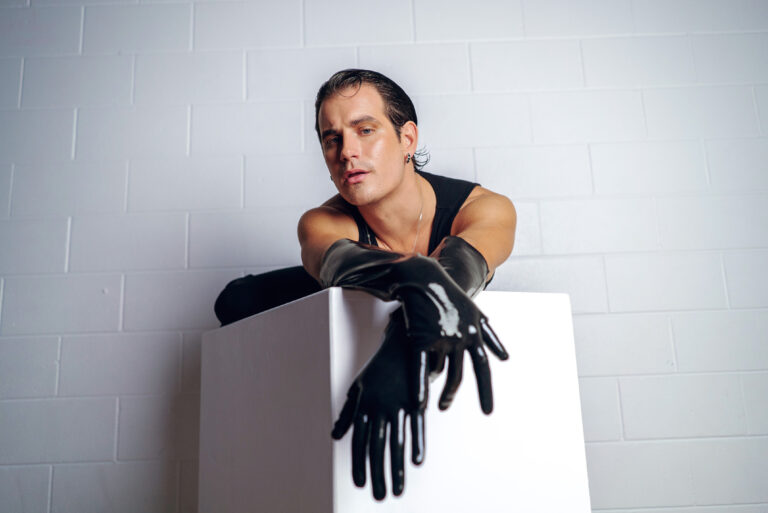It’s a Sunday morning at the Gibney Dance Center in New York City, where Ranee Ramaswamy and her daughters Aparna and Ashwini are preparing for a photo shoot. Chattering and interrupting each other, they flit about as they text, drink coffee and appraise one another’s appearance. Ranee proudly shows photos of her grandsons, “Aparna’s boys. Twins. Such big eyes!” This could be a friendly group of women, anywhere. But once in front of the camera, the members of Ragamala Dance Company instantly snap into focus—they are consummate performers who take the spotlight with grace and authority.
Ranee and her older daughter Aparna founded the Minneapolis-based Ragamala in 1992 as co-artistic directors, and it’s that intergenerational factor that gives the company its unique dynamic. The women perform in the classical South Indian dance form, bharata natyam, that Ranee studied as a child growing up in India. But theirs is not a story about a mother passing on a cultural tradition to her daughters. In fact, it was Aparna who paved the way for her mother to have the kind of career Ranee never dreamed possible.
From left: Ashwini, Ranee, Aparna in performance. Photo by Darial Sneed, courtesy of Ragamala.
A Return to Her Roots
Despite her upbringing, Ranee assumed dance would have no place in her new life in the U.S. Back in South India, her parents had denied her the traditional recital at the end of her bharata natyam training. “At 17, I was engaged to be married—an arranged marriage,” she says. “They said, ‘All that money we can spend on dowry.'” But once she and her husband arrived in Minnesota in 1981 (she was 26), she was asked to perform at a community ballet function. She cobbled together what steps she could remember and played a tape of Indian music. “I found that I still had a big love for the artform.”
After the concert, several families asked if she could teach their children. “Aparna was a young child,” says Ranee. “I wasn’t teaching her. Because these people were paying me, I thought, ‘I owe it to them, not my daughter.’ Then one day I looked—she knew everything I was teaching the other children!”
Aparna’s natural talent was confirmed when famed bharata natyam dancer and teacher Alarmél Valli (“She’s like the Baryshnikov of India,” says Ranee) performed in Minneapolis, and both mother and daughter took her advanced master class.
“Nobody could do anything,” says Ranee. “But Aparna was able to learn everything Valli taught. At the end, Valli said, ‘Aparna’s like a computer.'” When she suggested that Ranee bring Aparna to India for further instruction, Ranee didn’t hesitate. “Two months later, Aparna and I were already landed in India,” she says. “I said, ‘Can I also learn? I’ll work so hard.’ So I started from step A with Aparna—we became colleagues.” That partnership eventually grew into Ragamala, founded when Aparna was only 17.
Aparna and her mother are equal partners in directing the company. Photo by Jonathan Chapman, courtesy of Ragamala.
An American Influence
Ranee’s second daughter, Ashwini, followed a strikingly different path. Twelve when her sister and mother formed Ragamala, Ashwini danced in many of the company’s productions through college but never approached it with the drive of her mother and sister. “I did dance as one activity among many,” she says. “I’m very much an American kid.” But after working after college as a publicist for Penguin Books, she realized something was missing. “There was something not fulfilling that I couldn’t put my finger on,” she says. “So in 2007 I returned home. Every year, I get more pulled in.”
A talented soloist in her own right (“Now I’m meticulous; I’m practicing hours a day”), Ashwini also handles the company’s publicity. Though she admits she sometimes regrets not focusing on bharata natyam as a child, she thinks developing an interest later in life has made her a better performer today. “All those experiences have made my dancing what it is,” she explains. “What we’re always taught is to bring our personalities onstage, using the choreography, because bharata natyam is an externalization of internal emotion.”
Ashwini performs. Photo by Amanulla, courtesy of Ragamala.
Blending Cultures
When the Ramaswamy women describe their artform, the rigor and training sound similar to ballet, despite the obvious visual differences. Though bharata natyam precedes ballet by about 2,000 years—it’s taken from the four scriptures that exist in the Hindu religious tradition—it shares with ballet a dual focus on rhythm and expression. “From your eyebrows to your toes, every part of the body integrates the rhythm,” says Ranee. “It’s very complex.” But one difference is an element of personal interpretation. “When a dancer has fully absorbed the technique, the musicality, the spirituality, she is then able to internalize the idiom and make spontaneous decisions onstage—especially with live music,” says Ashwini. “If you practice, practice, practice with your musicians, you have the freedom to use different steps or rhythmic choices or explore different nuances of expression. It happens in the moment, but only after years of practice and confidence.”
And because they live in America, the Ramaswamys bring a new dimension to the traditional bharata natyam form. For instance, Ranee and Aparna have taken what is primarily a solo form of dance and expanded it for a group, often including other Western influences, like jazz music and improvisation. “If the link is perfect—if there is a connection between these things—we try to bring it all together in a conversation,” she says. “We keep bharata natyam very pure. But it has to change in ways, because it’s meeting with other music and cultures.”
Ranee in performance. Photo by Grant Halverson, courtesy of Ragamala.
The Next Generation
Though their particular way of interacting with one another—interrupting, offering unsolicited opinions—might suggest otherwise, all three women insist that there’s rarely discord among them. Ranee credits this to the time she and Aparna studied together in India with Valli. “Even though I am the mother, we became students at the same time,” she says. “I have never dismissed her as young, and she has never dismissed me as old.” Though Aparna agrees with her mother about their rapport, she admits the dynamic can be challenging. “The line between family and work has always been blurred for me, because my mom and I started this journey when I was very young,” she says. “Sometimes it can feel overwhelming,” adds Ashwini. “But it’s also extremely satisfying and emotionally enriching to work together.”
One of Ranee’s favorite things to say is that she gets to take her kids with her to work every day. “Continuing this lineage through my children is tremendously meaningful to me,” she says. Aparna, on the other hand, says that because her children are boys (6-year-old twins), she doesn’t have the same need to pass the bharata natyam torch to them. “I was so happy that they weren’t girls,” she says, “who would have to carry on the tradition. I feel like I’m experiencing a real childhood through my kids.”
All three women do pass on the bharata natyam tradition via their school, where they teach class to 40 dancers, ages 7 through adult. Having studied under and with one another for so many years, none of them takes this responsibility lightly. “In India, the teacher is one of the most important people in your life,” explains Ranee. “It’s mother, father, teacher, god. Mother gives you birth; father educates you; teacher shows you the path to knowledge. That’s the highest.”



